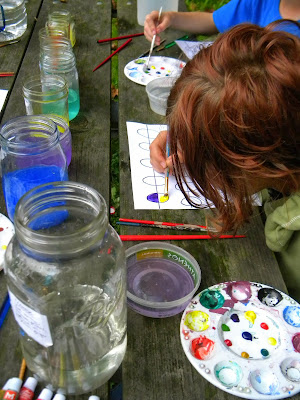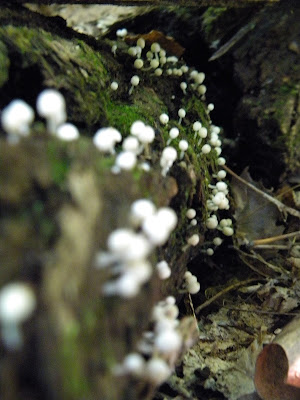One of our cooperative learning days found me with these three in the woods. Our goal was simply to walk the creek, and see what we could see...lots of leaves down, walnuts, pawpaws, some minnows, and, of course, I found some fungus.
 |
| pawpaw masquerading as a rock |
 |
| three little chipmunks on a rock |
My friend M. had just had a similar sentiment to Ani's expressed to her by her son, Noah: enough with the overt teaching, let's just do it. However, she is an ultra-prepared and optimistic planner (somewhat like myself...) who threw a microscope and a few measuring tools in the back of our car just in case. I had to laugh that the only tool that got used that morning was the meat thermometer, while everyone took turns taking the temperature of their lunch. Apparently most sandwiches, while being eaten al fresco, maintain a steady 62 degrees.
 |
| what IS this?! some sort of hairy organism, hanging from a branch |
After lunch, and before a downpour, we explored an activity that I did with the girls a few years back. After passing out glass jars in various sizes, and exploring the sounds they made when struck with wooden chopsticks, we added water to each jar. Each kid had three jars, and experimented by themselves with adding and taking away the water (what made the sound higher? lower? did striking the jar in different places change the sound?). Then I asked them to arrange their three jars from lowest tone to highest tone. This took a while, as some of the tones were very close. Sometimes we sang to match the pitch to figure out which was higher, which was lower. When that was done, we combined the jars into our own kind of scale, lowest to highest, tweaking along the way to make more disparate tones.
Once they were satisfied and agreed on the tones, we added color to the water. Much discussion here - should the highest note be purple, or the lowest? Is yellow a high color? Where does deep red fit in?
The next step was composing some music to go with the instrument.
Some of the circles were filled with one color; some were split between two colors, and were usually played like a trill between two jars.
Eliza finished her piece and moved on to play with illustrating repeated notes, long notes, and ways in which high and low notes could be indicated. She's a music reader, so this part made sense to her. I think it would have taken more time to play for the other two to get this variation, and to be honest, for all of them the project could probably have stopped with "ok, here are some jars; what sounds can they make?" They played them upside-down (muffled) and right-side up (ringing), along the rim, on the sides. I forget how that simple exploration can be so engaging.
We finished by tossing the colored water into the bushes and making a break for the car in the rain, but before that happened we had a chance to perform our pieces for each other!

































































